Water and Energy Consumption Patterns in Australia and Qatar
VerifiedAdded on 2020/04/07
|11
|2331
|40
AI Summary
This assignment analyzes the water and energy consumption patterns of Australia and Qatar, comparing their governmental initiatives for energy and water management policy implementation. It also examines the technological advancements made by both countries regarding water and energy technology. Finally, the report provides a comparative analysis of the measures taken by Australia and Qatar to address these crucial sustainability challenges.
Contribute Materials
Your contribution can guide someone’s learning journey. Share your
documents today.
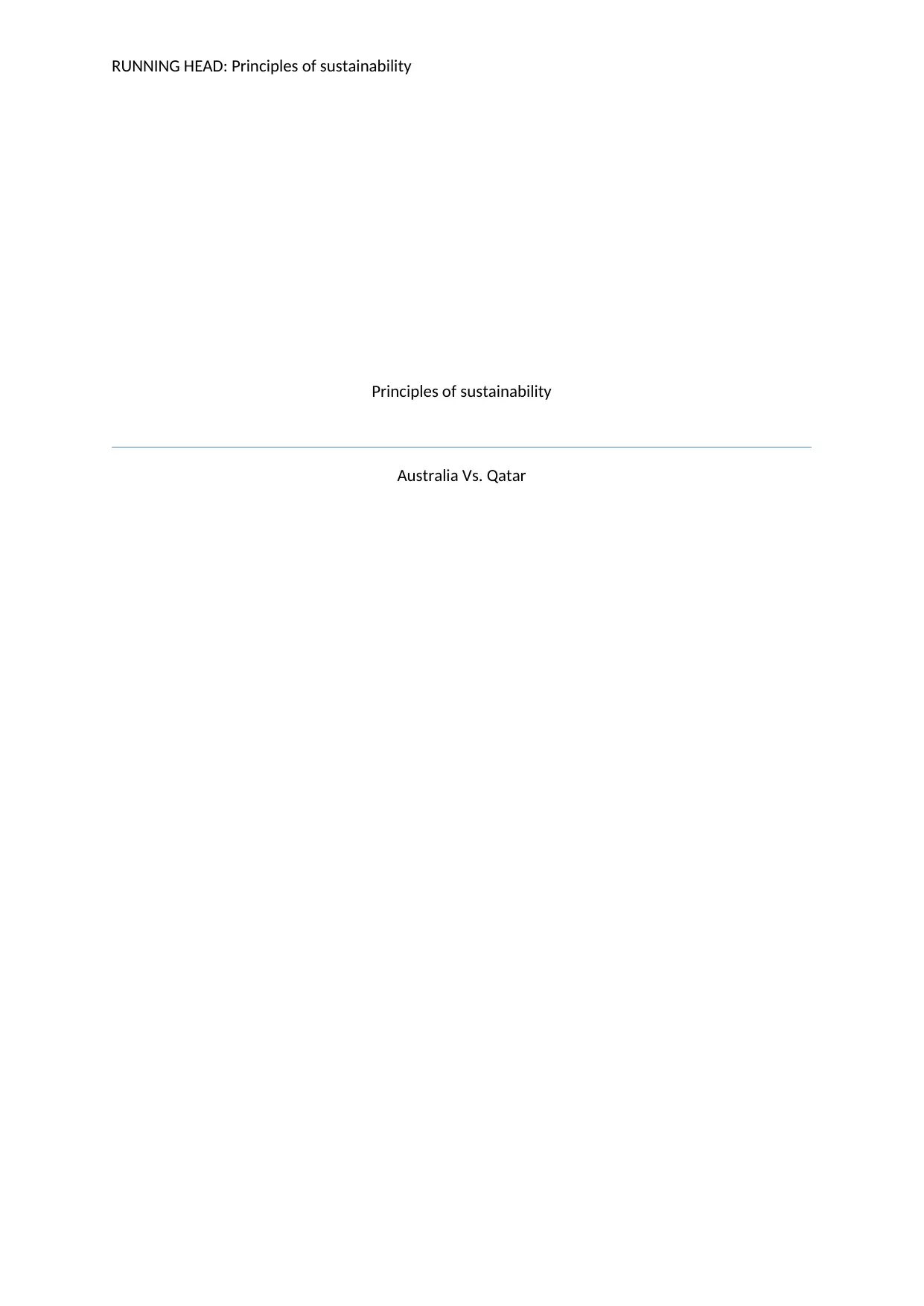
RUNNING HEAD: Principles of sustainability
Principles of sustainability
Australia Vs. Qatar
Principles of sustainability
Australia Vs. Qatar
Secure Best Marks with AI Grader
Need help grading? Try our AI Grader for instant feedback on your assignments.
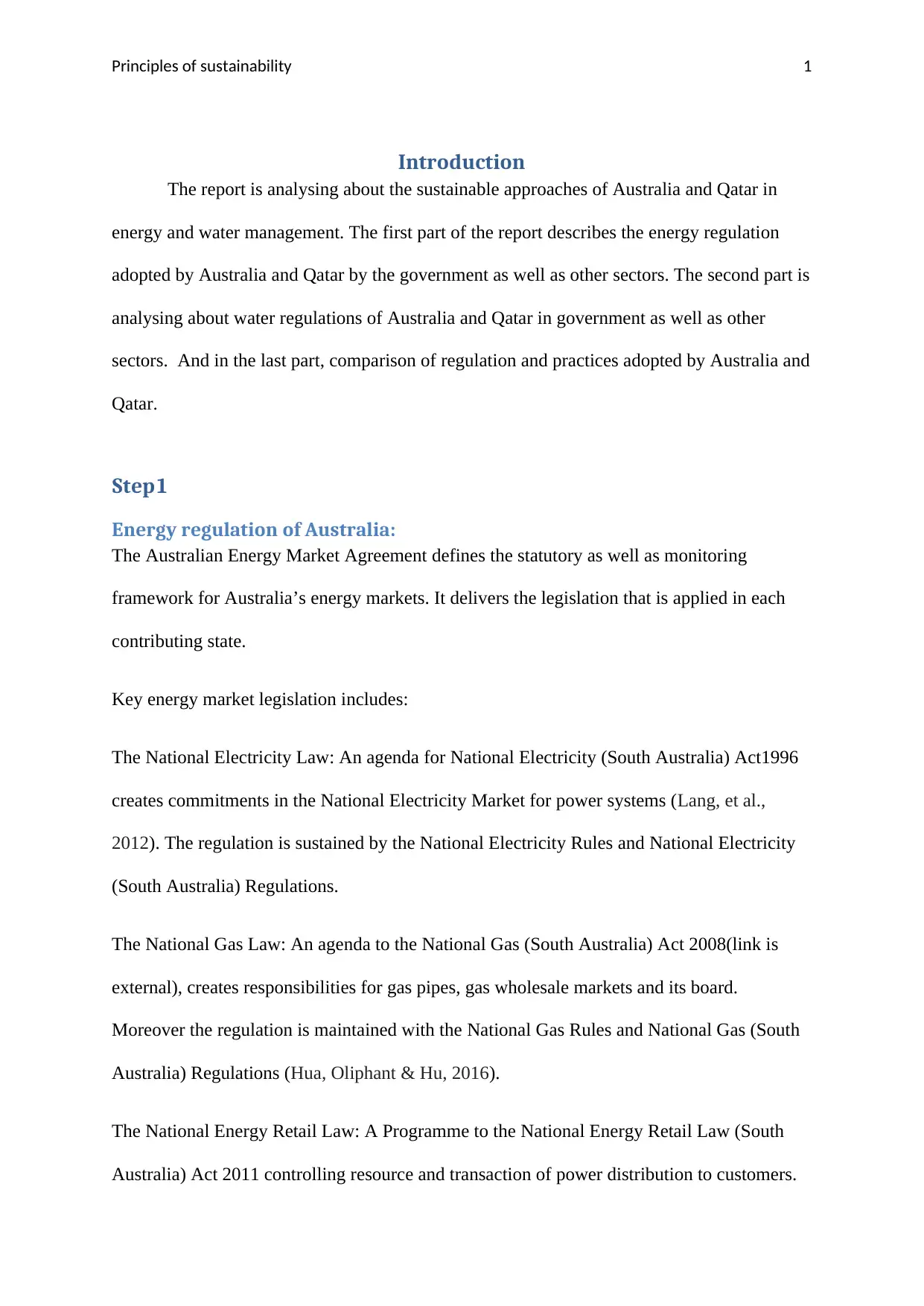
Principles of sustainability 1
Introduction
The report is analysing about the sustainable approaches of Australia and Qatar in
energy and water management. The first part of the report describes the energy regulation
adopted by Australia and Qatar by the government as well as other sectors. The second part is
analysing about water regulations of Australia and Qatar in government as well as other
sectors. And in the last part, comparison of regulation and practices adopted by Australia and
Qatar.
Step1
Energy regulation of Australia:
The Australian Energy Market Agreement defines the statutory as well as monitoring
framework for Australia’s energy markets. It delivers the legislation that is applied in each
contributing state.
Key energy market legislation includes:
The National Electricity Law: An agenda for National Electricity (South Australia) Act1996
creates commitments in the National Electricity Market for power systems (Lang, et al.,
2012). The regulation is sustained by the National Electricity Rules and National Electricity
(South Australia) Regulations.
The National Gas Law: An agenda to the National Gas (South Australia) Act 2008(link is
external), creates responsibilities for gas pipes, gas wholesale markets and its board.
Moreover the regulation is maintained with the National Gas Rules and National Gas (South
Australia) Regulations (Hua, Oliphant & Hu, 2016).
The National Energy Retail Law: A Programme to the National Energy Retail Law (South
Australia) Act 2011 controlling resource and transaction of power distribution to customers.
Introduction
The report is analysing about the sustainable approaches of Australia and Qatar in
energy and water management. The first part of the report describes the energy regulation
adopted by Australia and Qatar by the government as well as other sectors. The second part is
analysing about water regulations of Australia and Qatar in government as well as other
sectors. And in the last part, comparison of regulation and practices adopted by Australia and
Qatar.
Step1
Energy regulation of Australia:
The Australian Energy Market Agreement defines the statutory as well as monitoring
framework for Australia’s energy markets. It delivers the legislation that is applied in each
contributing state.
Key energy market legislation includes:
The National Electricity Law: An agenda for National Electricity (South Australia) Act1996
creates commitments in the National Electricity Market for power systems (Lang, et al.,
2012). The regulation is sustained by the National Electricity Rules and National Electricity
(South Australia) Regulations.
The National Gas Law: An agenda to the National Gas (South Australia) Act 2008(link is
external), creates responsibilities for gas pipes, gas wholesale markets and its board.
Moreover the regulation is maintained with the National Gas Rules and National Gas (South
Australia) Regulations (Hua, Oliphant & Hu, 2016).
The National Energy Retail Law: A Programme to the National Energy Retail Law (South
Australia) Act 2011 controlling resource and transaction of power distribution to customers.
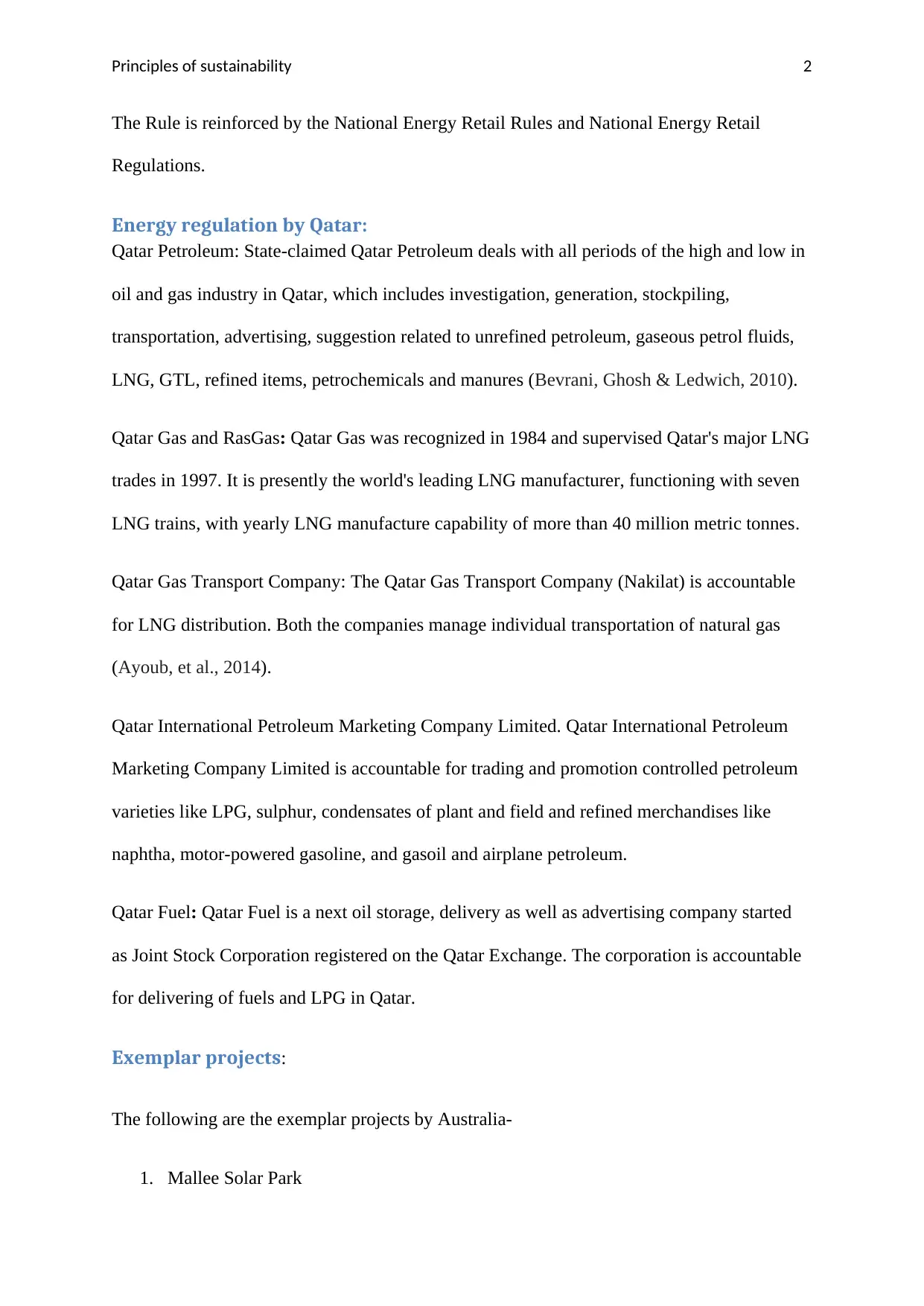
Principles of sustainability 2
The Rule is reinforced by the National Energy Retail Rules and National Energy Retail
Regulations.
Energy regulation by Qatar:
Qatar Petroleum: State-claimed Qatar Petroleum deals with all periods of the high and low in
oil and gas industry in Qatar, which includes investigation, generation, stockpiling,
transportation, advertising, suggestion related to unrefined petroleum, gaseous petrol fluids,
LNG, GTL, refined items, petrochemicals and manures (Bevrani, Ghosh & Ledwich, 2010).
Qatar Gas and RasGas: Qatar Gas was recognized in 1984 and supervised Qatar's major LNG
trades in 1997. It is presently the world's leading LNG manufacturer, functioning with seven
LNG trains, with yearly LNG manufacture capability of more than 40 million metric tonnes.
Qatar Gas Transport Company: The Qatar Gas Transport Company (Nakilat) is accountable
for LNG distribution. Both the companies manage individual transportation of natural gas
(Ayoub, et al., 2014).
Qatar International Petroleum Marketing Company Limited. Qatar International Petroleum
Marketing Company Limited is accountable for trading and promotion controlled petroleum
varieties like LPG, sulphur, condensates of plant and field and refined merchandises like
naphtha, motor-powered gasoline, and gasoil and airplane petroleum.
Qatar Fuel: Qatar Fuel is a next oil storage, delivery as well as advertising company started
as Joint Stock Corporation registered on the Qatar Exchange. The corporation is accountable
for delivering of fuels and LPG in Qatar.
Exemplar projects:
The following are the exemplar projects by Australia-
1. Mallee Solar Park
The Rule is reinforced by the National Energy Retail Rules and National Energy Retail
Regulations.
Energy regulation by Qatar:
Qatar Petroleum: State-claimed Qatar Petroleum deals with all periods of the high and low in
oil and gas industry in Qatar, which includes investigation, generation, stockpiling,
transportation, advertising, suggestion related to unrefined petroleum, gaseous petrol fluids,
LNG, GTL, refined items, petrochemicals and manures (Bevrani, Ghosh & Ledwich, 2010).
Qatar Gas and RasGas: Qatar Gas was recognized in 1984 and supervised Qatar's major LNG
trades in 1997. It is presently the world's leading LNG manufacturer, functioning with seven
LNG trains, with yearly LNG manufacture capability of more than 40 million metric tonnes.
Qatar Gas Transport Company: The Qatar Gas Transport Company (Nakilat) is accountable
for LNG distribution. Both the companies manage individual transportation of natural gas
(Ayoub, et al., 2014).
Qatar International Petroleum Marketing Company Limited. Qatar International Petroleum
Marketing Company Limited is accountable for trading and promotion controlled petroleum
varieties like LPG, sulphur, condensates of plant and field and refined merchandises like
naphtha, motor-powered gasoline, and gasoil and airplane petroleum.
Qatar Fuel: Qatar Fuel is a next oil storage, delivery as well as advertising company started
as Joint Stock Corporation registered on the Qatar Exchange. The corporation is accountable
for delivering of fuels and LPG in Qatar.
Exemplar projects:
The following are the exemplar projects by Australia-
1. Mallee Solar Park
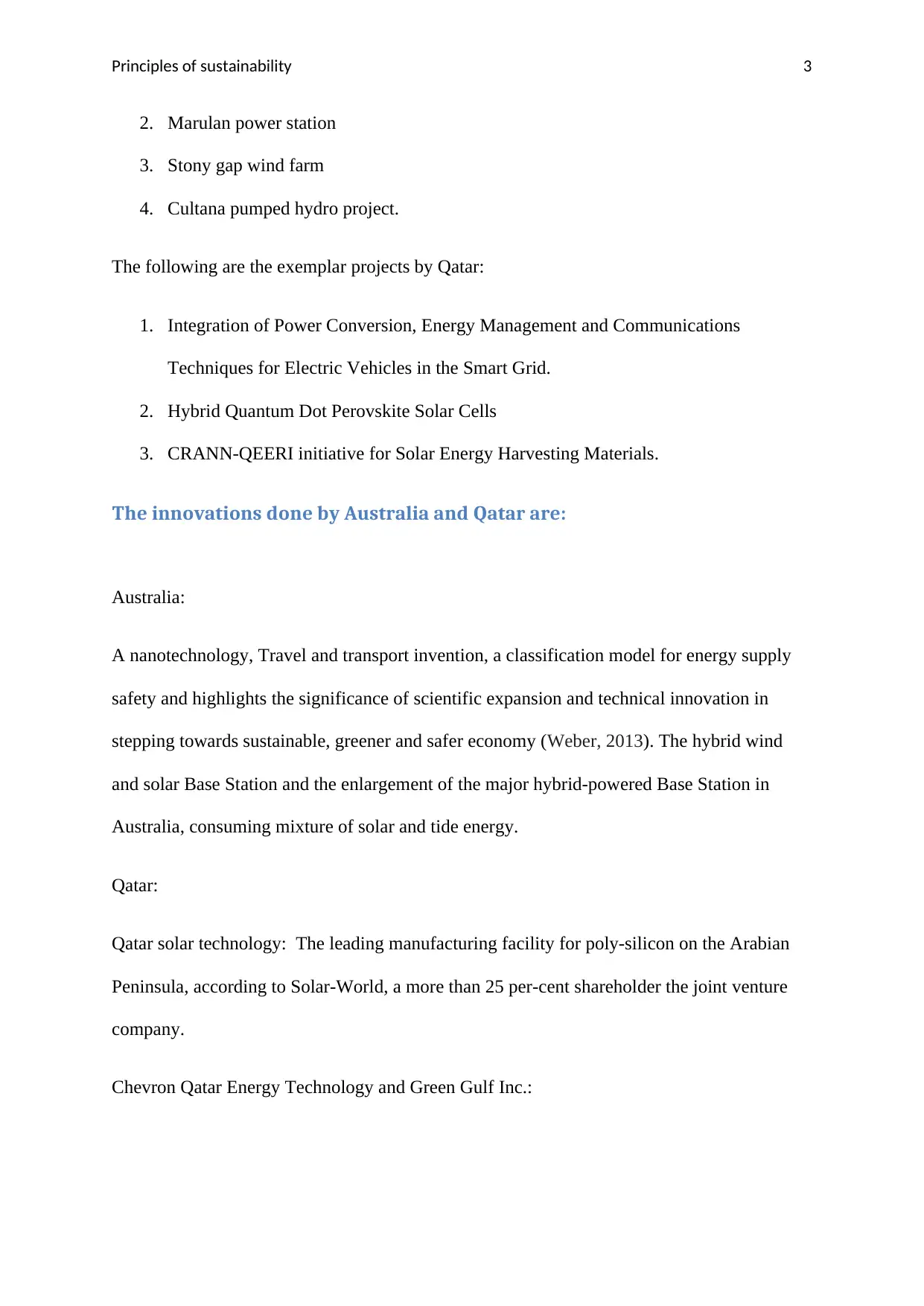
Principles of sustainability 3
2. Marulan power station
3. Stony gap wind farm
4. Cultana pumped hydro project.
The following are the exemplar projects by Qatar:
1. Integration of Power Conversion, Energy Management and Communications
Techniques for Electric Vehicles in the Smart Grid.
2. Hybrid Quantum Dot Perovskite Solar Cells
3. CRANN-QEERI initiative for Solar Energy Harvesting Materials.
The innovations done by Australia and Qatar are:
Australia:
A nanotechnology, Travel and transport invention, a classification model for energy supply
safety and highlights the significance of scientific expansion and technical innovation in
stepping towards sustainable, greener and safer economy (Weber, 2013). The hybrid wind
and solar Base Station and the enlargement of the major hybrid-powered Base Station in
Australia, consuming mixture of solar and tide energy.
Qatar:
Qatar solar technology: The leading manufacturing facility for poly-silicon on the Arabian
Peninsula, according to Solar-World, a more than 25 per-cent shareholder the joint venture
company.
Chevron Qatar Energy Technology and Green Gulf Inc.:
2. Marulan power station
3. Stony gap wind farm
4. Cultana pumped hydro project.
The following are the exemplar projects by Qatar:
1. Integration of Power Conversion, Energy Management and Communications
Techniques for Electric Vehicles in the Smart Grid.
2. Hybrid Quantum Dot Perovskite Solar Cells
3. CRANN-QEERI initiative for Solar Energy Harvesting Materials.
The innovations done by Australia and Qatar are:
Australia:
A nanotechnology, Travel and transport invention, a classification model for energy supply
safety and highlights the significance of scientific expansion and technical innovation in
stepping towards sustainable, greener and safer economy (Weber, 2013). The hybrid wind
and solar Base Station and the enlargement of the major hybrid-powered Base Station in
Australia, consuming mixture of solar and tide energy.
Qatar:
Qatar solar technology: The leading manufacturing facility for poly-silicon on the Arabian
Peninsula, according to Solar-World, a more than 25 per-cent shareholder the joint venture
company.
Chevron Qatar Energy Technology and Green Gulf Inc.:
Secure Best Marks with AI Grader
Need help grading? Try our AI Grader for instant feedback on your assignments.
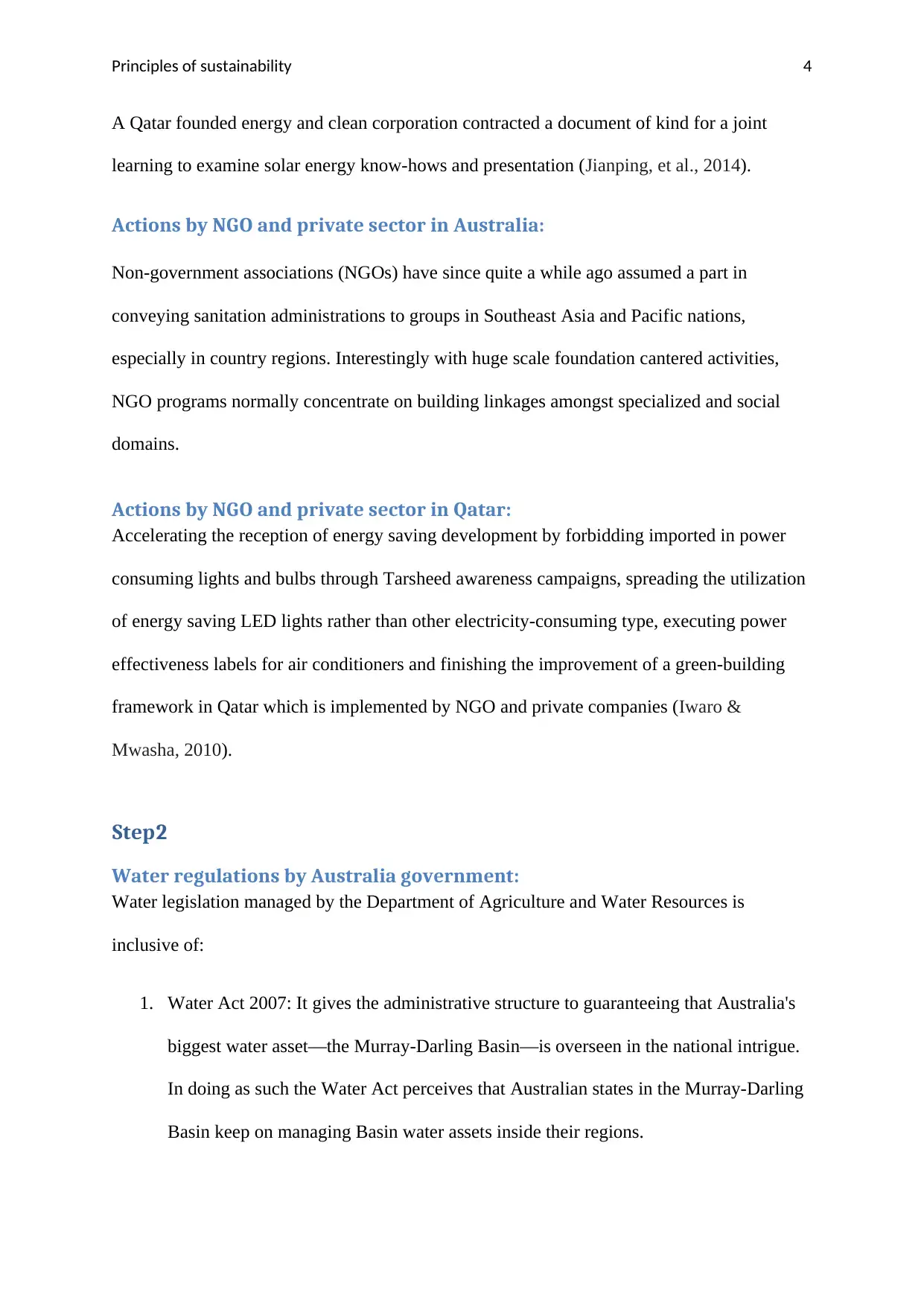
Principles of sustainability 4
A Qatar founded energy and clean corporation contracted a document of kind for a joint
learning to examine solar energy know-hows and presentation (Jianping, et al., 2014).
Actions by NGO and private sector in Australia:
Non-government associations (NGOs) have since quite a while ago assumed a part in
conveying sanitation administrations to groups in Southeast Asia and Pacific nations,
especially in country regions. Interestingly with huge scale foundation cantered activities,
NGO programs normally concentrate on building linkages amongst specialized and social
domains.
Actions by NGO and private sector in Qatar:
Accelerating the reception of energy saving development by forbidding imported in power
consuming lights and bulbs through Tarsheed awareness campaigns, spreading the utilization
of energy saving LED lights rather than other electricity-consuming type, executing power
effectiveness labels for air conditioners and finishing the improvement of a green-building
framework in Qatar which is implemented by NGO and private companies (Iwaro &
Mwasha, 2010).
Step2
Water regulations by Australia government:
Water legislation managed by the Department of Agriculture and Water Resources is
inclusive of:
1. Water Act 2007: It gives the administrative structure to guaranteeing that Australia's
biggest water asset—the Murray-Darling Basin—is overseen in the national intrigue.
In doing as such the Water Act perceives that Australian states in the Murray-Darling
Basin keep on managing Basin water assets inside their regions.
A Qatar founded energy and clean corporation contracted a document of kind for a joint
learning to examine solar energy know-hows and presentation (Jianping, et al., 2014).
Actions by NGO and private sector in Australia:
Non-government associations (NGOs) have since quite a while ago assumed a part in
conveying sanitation administrations to groups in Southeast Asia and Pacific nations,
especially in country regions. Interestingly with huge scale foundation cantered activities,
NGO programs normally concentrate on building linkages amongst specialized and social
domains.
Actions by NGO and private sector in Qatar:
Accelerating the reception of energy saving development by forbidding imported in power
consuming lights and bulbs through Tarsheed awareness campaigns, spreading the utilization
of energy saving LED lights rather than other electricity-consuming type, executing power
effectiveness labels for air conditioners and finishing the improvement of a green-building
framework in Qatar which is implemented by NGO and private companies (Iwaro &
Mwasha, 2010).
Step2
Water regulations by Australia government:
Water legislation managed by the Department of Agriculture and Water Resources is
inclusive of:
1. Water Act 2007: It gives the administrative structure to guaranteeing that Australia's
biggest water asset—the Murray-Darling Basin—is overseen in the national intrigue.
In doing as such the Water Act perceives that Australian states in the Murray-Darling
Basin keep on managing Basin water assets inside their regions.
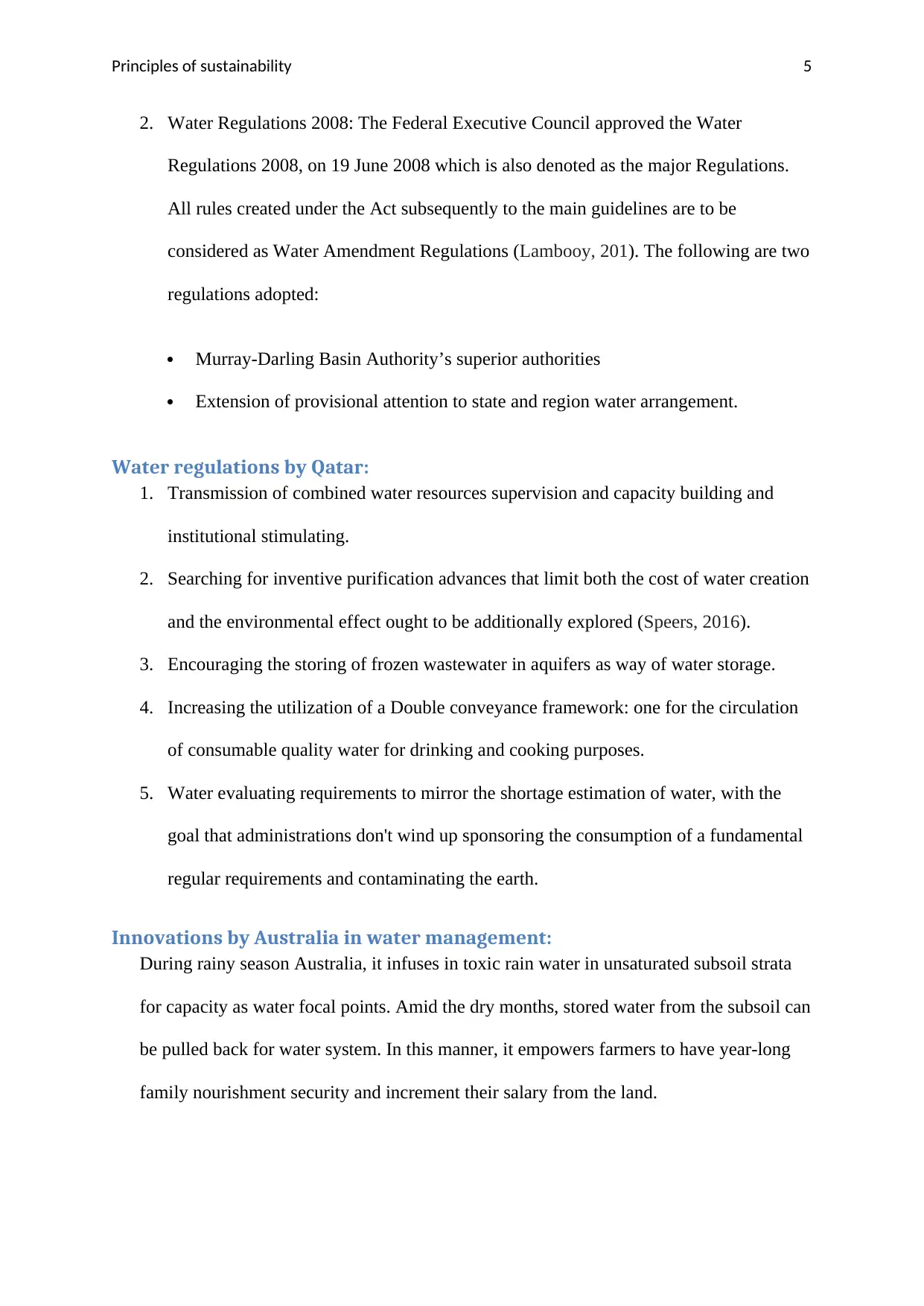
Principles of sustainability 5
2. Water Regulations 2008: The Federal Executive Council approved the Water
Regulations 2008, on 19 June 2008 which is also denoted as the major Regulations.
All rules created under the Act subsequently to the main guidelines are to be
considered as Water Amendment Regulations (Lambooy, 201). The following are two
regulations adopted:
Murray-Darling Basin Authority’s superior authorities
Extension of provisional attention to state and region water arrangement.
Water regulations by Qatar:
1. Transmission of combined water resources supervision and capacity building and
institutional stimulating.
2. Searching for inventive purification advances that limit both the cost of water creation
and the environmental effect ought to be additionally explored (Speers, 2016).
3. Encouraging the storing of frozen wastewater in aquifers as way of water storage.
4. Increasing the utilization of a Double conveyance framework: one for the circulation
of consumable quality water for drinking and cooking purposes.
5. Water evaluating requirements to mirror the shortage estimation of water, with the
goal that administrations don't wind up sponsoring the consumption of a fundamental
regular requirements and contaminating the earth.
Innovations by Australia in water management:
During rainy season Australia, it infuses in toxic rain water in unsaturated subsoil strata
for capacity as water focal points. Amid the dry months, stored water from the subsoil can
be pulled back for water system. In this manner, it empowers farmers to have year-long
family nourishment security and increment their salary from the land.
2. Water Regulations 2008: The Federal Executive Council approved the Water
Regulations 2008, on 19 June 2008 which is also denoted as the major Regulations.
All rules created under the Act subsequently to the main guidelines are to be
considered as Water Amendment Regulations (Lambooy, 201). The following are two
regulations adopted:
Murray-Darling Basin Authority’s superior authorities
Extension of provisional attention to state and region water arrangement.
Water regulations by Qatar:
1. Transmission of combined water resources supervision and capacity building and
institutional stimulating.
2. Searching for inventive purification advances that limit both the cost of water creation
and the environmental effect ought to be additionally explored (Speers, 2016).
3. Encouraging the storing of frozen wastewater in aquifers as way of water storage.
4. Increasing the utilization of a Double conveyance framework: one for the circulation
of consumable quality water for drinking and cooking purposes.
5. Water evaluating requirements to mirror the shortage estimation of water, with the
goal that administrations don't wind up sponsoring the consumption of a fundamental
regular requirements and contaminating the earth.
Innovations by Australia in water management:
During rainy season Australia, it infuses in toxic rain water in unsaturated subsoil strata
for capacity as water focal points. Amid the dry months, stored water from the subsoil can
be pulled back for water system. In this manner, it empowers farmers to have year-long
family nourishment security and increment their salary from the land.
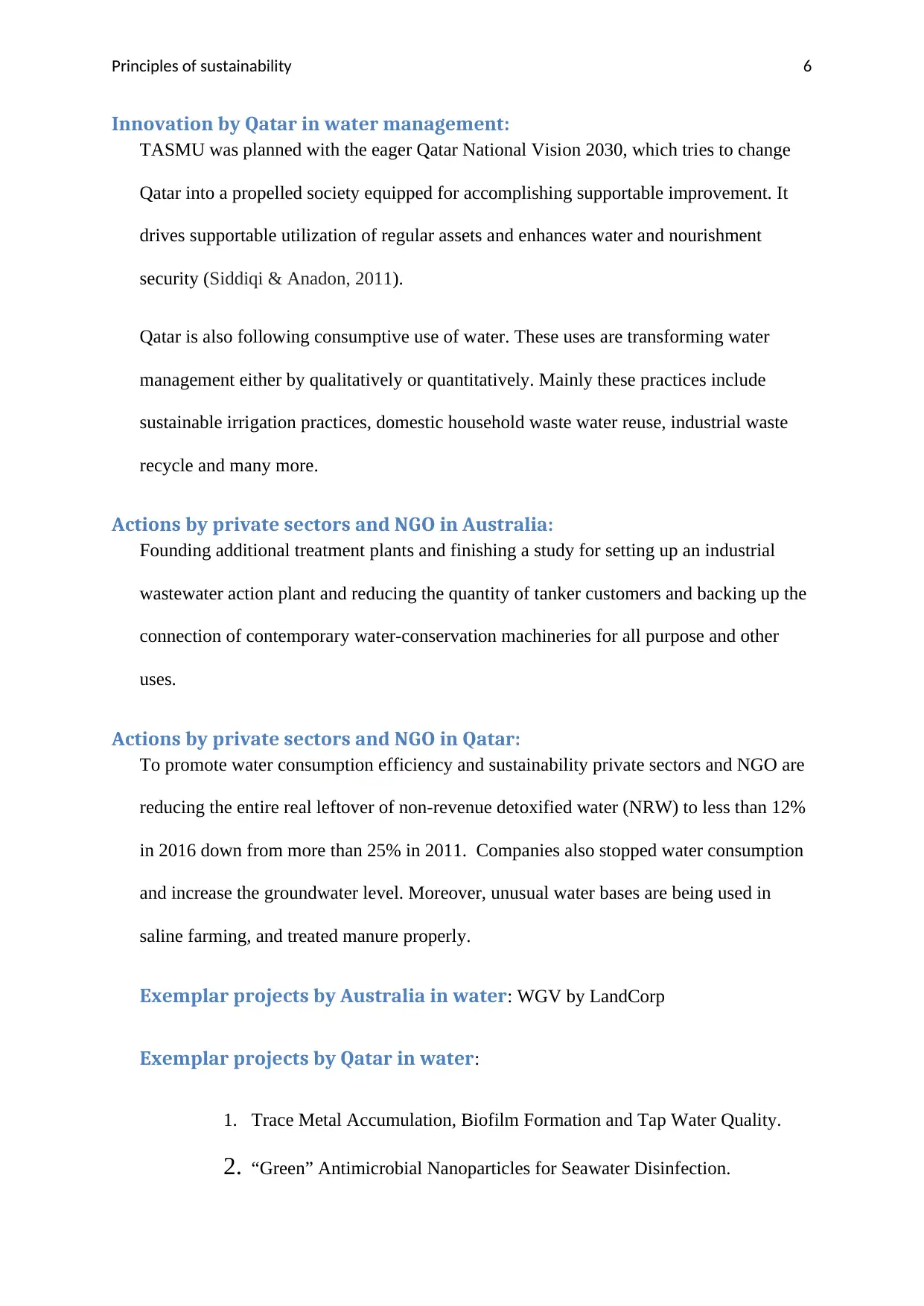
Principles of sustainability 6
Innovation by Qatar in water management:
TASMU was planned with the eager Qatar National Vision 2030, which tries to change
Qatar into a propelled society equipped for accomplishing supportable improvement. It
drives supportable utilization of regular assets and enhances water and nourishment
security (Siddiqi & Anadon, 2011).
Qatar is also following consumptive use of water. These uses are transforming water
management either by qualitatively or quantitatively. Mainly these practices include
sustainable irrigation practices, domestic household waste water reuse, industrial waste
recycle and many more.
Actions by private sectors and NGO in Australia:
Founding additional treatment plants and finishing a study for setting up an industrial
wastewater action plant and reducing the quantity of tanker customers and backing up the
connection of contemporary water-conservation machineries for all purpose and other
uses.
Actions by private sectors and NGO in Qatar:
To promote water consumption efficiency and sustainability private sectors and NGO are
reducing the entire real leftover of non-revenue detoxified water (NRW) to less than 12%
in 2016 down from more than 25% in 2011. Companies also stopped water consumption
and increase the groundwater level. Moreover, unusual water bases are being used in
saline farming, and treated manure properly.
Exemplar projects by Australia in water: WGV by LandCorp
Exemplar projects by Qatar in water:
1. Trace Metal Accumulation, Biofilm Formation and Tap Water Quality.
2. “Green” Antimicrobial Nanoparticles for Seawater Disinfection.
Innovation by Qatar in water management:
TASMU was planned with the eager Qatar National Vision 2030, which tries to change
Qatar into a propelled society equipped for accomplishing supportable improvement. It
drives supportable utilization of regular assets and enhances water and nourishment
security (Siddiqi & Anadon, 2011).
Qatar is also following consumptive use of water. These uses are transforming water
management either by qualitatively or quantitatively. Mainly these practices include
sustainable irrigation practices, domestic household waste water reuse, industrial waste
recycle and many more.
Actions by private sectors and NGO in Australia:
Founding additional treatment plants and finishing a study for setting up an industrial
wastewater action plant and reducing the quantity of tanker customers and backing up the
connection of contemporary water-conservation machineries for all purpose and other
uses.
Actions by private sectors and NGO in Qatar:
To promote water consumption efficiency and sustainability private sectors and NGO are
reducing the entire real leftover of non-revenue detoxified water (NRW) to less than 12%
in 2016 down from more than 25% in 2011. Companies also stopped water consumption
and increase the groundwater level. Moreover, unusual water bases are being used in
saline farming, and treated manure properly.
Exemplar projects by Australia in water: WGV by LandCorp
Exemplar projects by Qatar in water:
1. Trace Metal Accumulation, Biofilm Formation and Tap Water Quality.
2. “Green” Antimicrobial Nanoparticles for Seawater Disinfection.
Paraphrase This Document
Need a fresh take? Get an instant paraphrase of this document with our AI Paraphraser
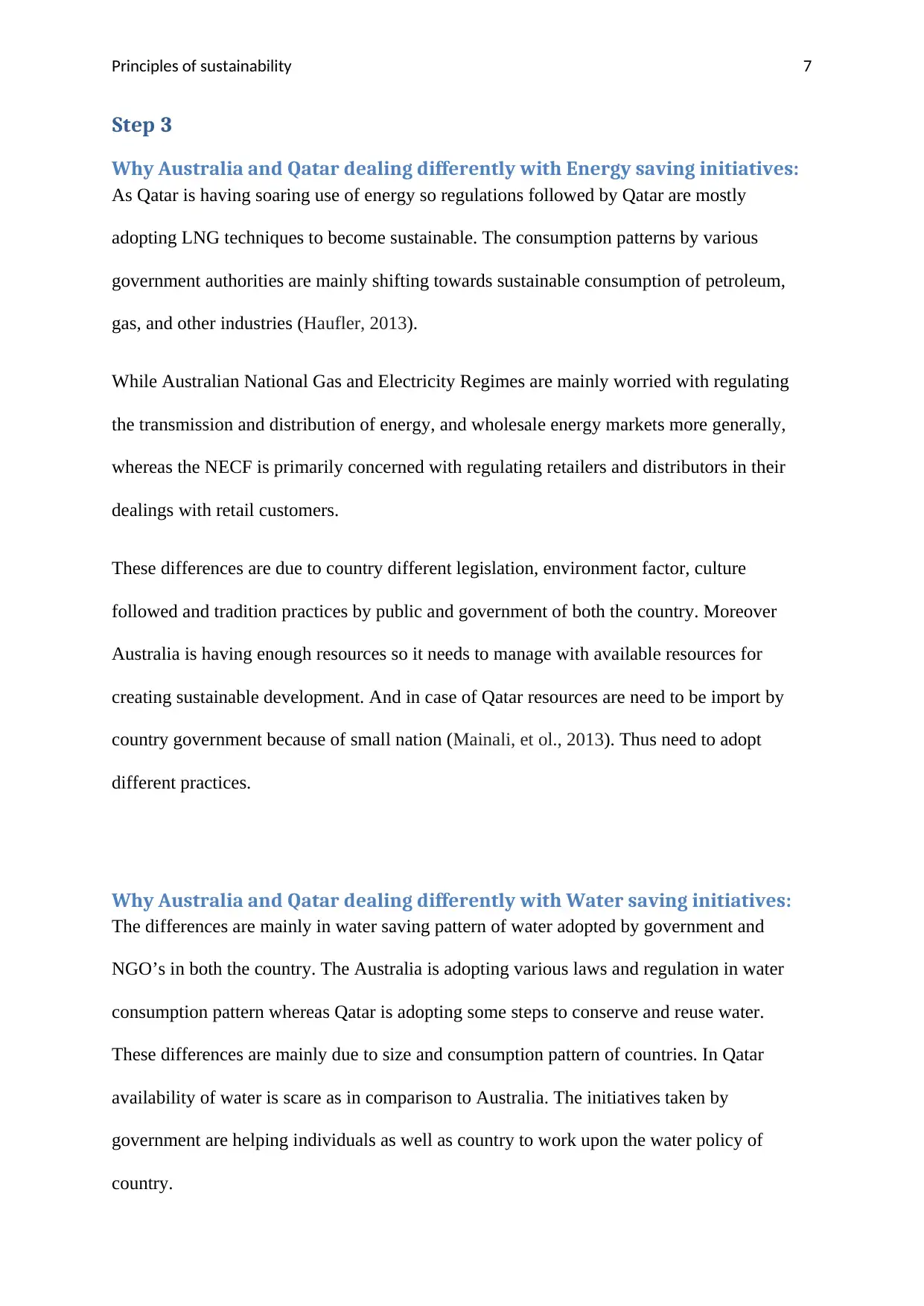
Principles of sustainability 7
Step 3
Why Australia and Qatar dealing differently with Energy saving initiatives:
As Qatar is having soaring use of energy so regulations followed by Qatar are mostly
adopting LNG techniques to become sustainable. The consumption patterns by various
government authorities are mainly shifting towards sustainable consumption of petroleum,
gas, and other industries (Haufler, 2013).
While Australian National Gas and Electricity Regimes are mainly worried with regulating
the transmission and distribution of energy, and wholesale energy markets more generally,
whereas the NECF is primarily concerned with regulating retailers and distributors in their
dealings with retail customers.
These differences are due to country different legislation, environment factor, culture
followed and tradition practices by public and government of both the country. Moreover
Australia is having enough resources so it needs to manage with available resources for
creating sustainable development. And in case of Qatar resources are need to be import by
country government because of small nation (Mainali, et ol., 2013). Thus need to adopt
different practices.
Why Australia and Qatar dealing differently with Water saving initiatives:
The differences are mainly in water saving pattern of water adopted by government and
NGO’s in both the country. The Australia is adopting various laws and regulation in water
consumption pattern whereas Qatar is adopting some steps to conserve and reuse water.
These differences are mainly due to size and consumption pattern of countries. In Qatar
availability of water is scare as in comparison to Australia. The initiatives taken by
government are helping individuals as well as country to work upon the water policy of
country.
Step 3
Why Australia and Qatar dealing differently with Energy saving initiatives:
As Qatar is having soaring use of energy so regulations followed by Qatar are mostly
adopting LNG techniques to become sustainable. The consumption patterns by various
government authorities are mainly shifting towards sustainable consumption of petroleum,
gas, and other industries (Haufler, 2013).
While Australian National Gas and Electricity Regimes are mainly worried with regulating
the transmission and distribution of energy, and wholesale energy markets more generally,
whereas the NECF is primarily concerned with regulating retailers and distributors in their
dealings with retail customers.
These differences are due to country different legislation, environment factor, culture
followed and tradition practices by public and government of both the country. Moreover
Australia is having enough resources so it needs to manage with available resources for
creating sustainable development. And in case of Qatar resources are need to be import by
country government because of small nation (Mainali, et ol., 2013). Thus need to adopt
different practices.
Why Australia and Qatar dealing differently with Water saving initiatives:
The differences are mainly in water saving pattern of water adopted by government and
NGO’s in both the country. The Australia is adopting various laws and regulation in water
consumption pattern whereas Qatar is adopting some steps to conserve and reuse water.
These differences are mainly due to size and consumption pattern of countries. In Qatar
availability of water is scare as in comparison to Australia. The initiatives taken by
government are helping individuals as well as country to work upon the water policy of
country.
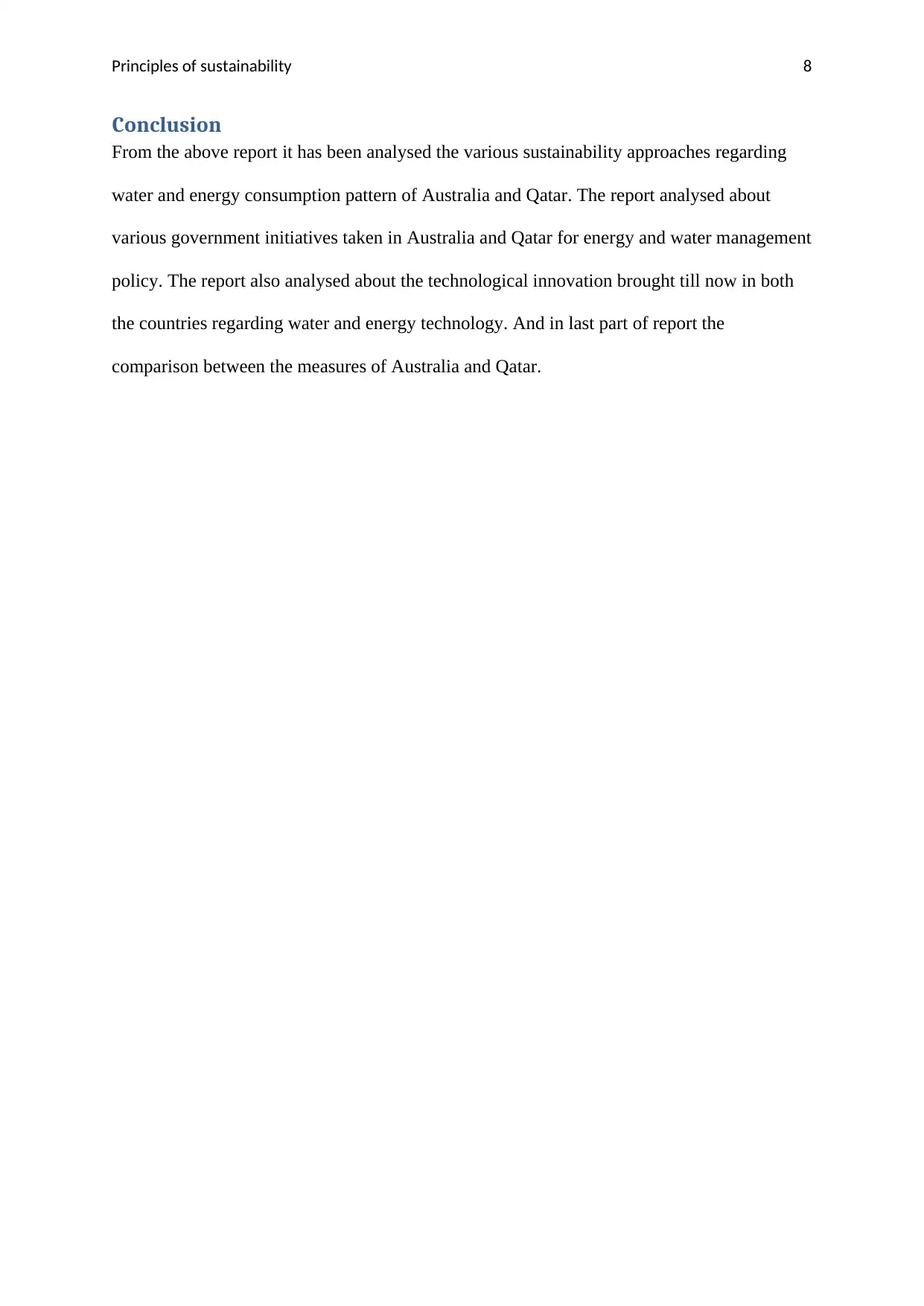
Principles of sustainability 8
Conclusion
From the above report it has been analysed the various sustainability approaches regarding
water and energy consumption pattern of Australia and Qatar. The report analysed about
various government initiatives taken in Australia and Qatar for energy and water management
policy. The report also analysed about the technological innovation brought till now in both
the countries regarding water and energy technology. And in last part of report the
comparison between the measures of Australia and Qatar.
Conclusion
From the above report it has been analysed the various sustainability approaches regarding
water and energy consumption pattern of Australia and Qatar. The report analysed about
various government initiatives taken in Australia and Qatar for energy and water management
policy. The report also analysed about the technological innovation brought till now in both
the countries regarding water and energy technology. And in last part of report the
comparison between the measures of Australia and Qatar.
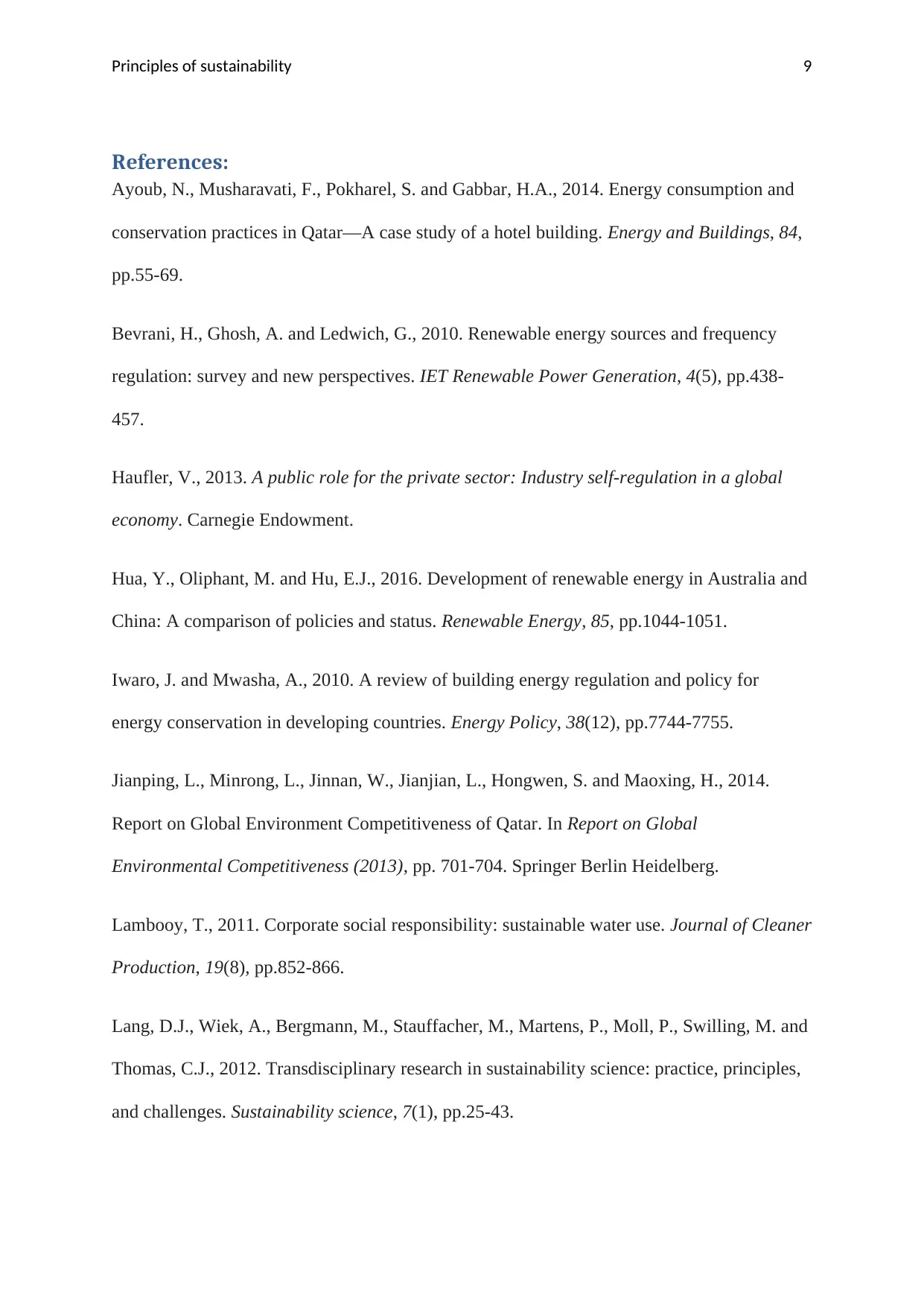
Principles of sustainability 9
References:
Ayoub, N., Musharavati, F., Pokharel, S. and Gabbar, H.A., 2014. Energy consumption and
conservation practices in Qatar—A case study of a hotel building. Energy and Buildings, 84,
pp.55-69.
Bevrani, H., Ghosh, A. and Ledwich, G., 2010. Renewable energy sources and frequency
regulation: survey and new perspectives. IET Renewable Power Generation, 4(5), pp.438-
457.
Haufler, V., 2013. A public role for the private sector: Industry self-regulation in a global
economy. Carnegie Endowment.
Hua, Y., Oliphant, M. and Hu, E.J., 2016. Development of renewable energy in Australia and
China: A comparison of policies and status. Renewable Energy, 85, pp.1044-1051.
Iwaro, J. and Mwasha, A., 2010. A review of building energy regulation and policy for
energy conservation in developing countries. Energy Policy, 38(12), pp.7744-7755.
Jianping, L., Minrong, L., Jinnan, W., Jianjian, L., Hongwen, S. and Maoxing, H., 2014.
Report on Global Environment Competitiveness of Qatar. In Report on Global
Environmental Competitiveness (2013), pp. 701-704. Springer Berlin Heidelberg.
Lambooy, T., 2011. Corporate social responsibility: sustainable water use. Journal of Cleaner
Production, 19(8), pp.852-866.
Lang, D.J., Wiek, A., Bergmann, M., Stauffacher, M., Martens, P., Moll, P., Swilling, M. and
Thomas, C.J., 2012. Transdisciplinary research in sustainability science: practice, principles,
and challenges. Sustainability science, 7(1), pp.25-43.
References:
Ayoub, N., Musharavati, F., Pokharel, S. and Gabbar, H.A., 2014. Energy consumption and
conservation practices in Qatar—A case study of a hotel building. Energy and Buildings, 84,
pp.55-69.
Bevrani, H., Ghosh, A. and Ledwich, G., 2010. Renewable energy sources and frequency
regulation: survey and new perspectives. IET Renewable Power Generation, 4(5), pp.438-
457.
Haufler, V., 2013. A public role for the private sector: Industry self-regulation in a global
economy. Carnegie Endowment.
Hua, Y., Oliphant, M. and Hu, E.J., 2016. Development of renewable energy in Australia and
China: A comparison of policies and status. Renewable Energy, 85, pp.1044-1051.
Iwaro, J. and Mwasha, A., 2010. A review of building energy regulation and policy for
energy conservation in developing countries. Energy Policy, 38(12), pp.7744-7755.
Jianping, L., Minrong, L., Jinnan, W., Jianjian, L., Hongwen, S. and Maoxing, H., 2014.
Report on Global Environment Competitiveness of Qatar. In Report on Global
Environmental Competitiveness (2013), pp. 701-704. Springer Berlin Heidelberg.
Lambooy, T., 2011. Corporate social responsibility: sustainable water use. Journal of Cleaner
Production, 19(8), pp.852-866.
Lang, D.J., Wiek, A., Bergmann, M., Stauffacher, M., Martens, P., Moll, P., Swilling, M. and
Thomas, C.J., 2012. Transdisciplinary research in sustainability science: practice, principles,
and challenges. Sustainability science, 7(1), pp.25-43.
Secure Best Marks with AI Grader
Need help grading? Try our AI Grader for instant feedback on your assignments.
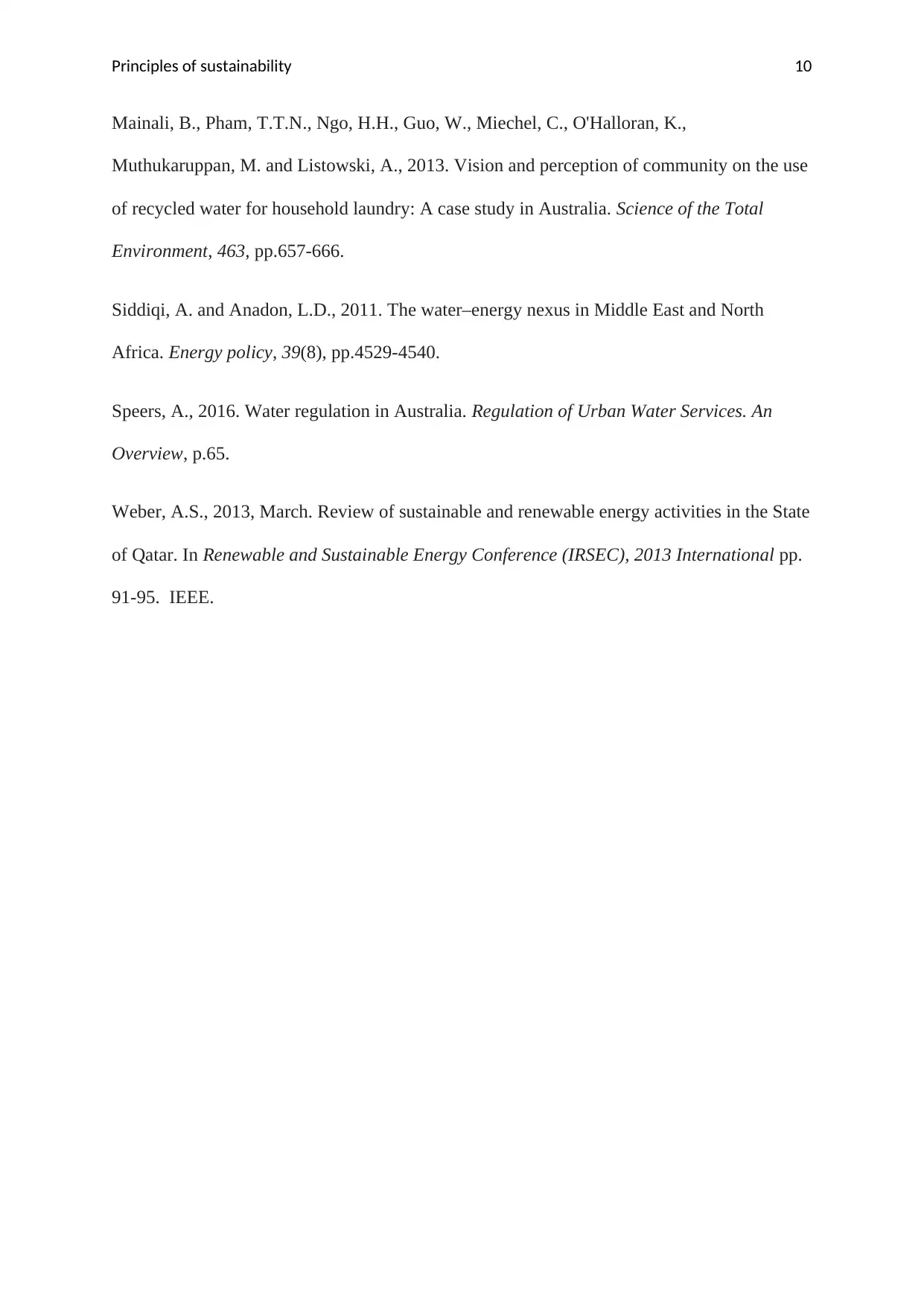
Principles of sustainability 10
Mainali, B., Pham, T.T.N., Ngo, H.H., Guo, W., Miechel, C., O'Halloran, K.,
Muthukaruppan, M. and Listowski, A., 2013. Vision and perception of community on the use
of recycled water for household laundry: A case study in Australia. Science of the Total
Environment, 463, pp.657-666.
Siddiqi, A. and Anadon, L.D., 2011. The water–energy nexus in Middle East and North
Africa. Energy policy, 39(8), pp.4529-4540.
Speers, A., 2016. Water regulation in Australia. Regulation of Urban Water Services. An
Overview, p.65.
Weber, A.S., 2013, March. Review of sustainable and renewable energy activities in the State
of Qatar. In Renewable and Sustainable Energy Conference (IRSEC), 2013 International pp.
91-95. IEEE.
Mainali, B., Pham, T.T.N., Ngo, H.H., Guo, W., Miechel, C., O'Halloran, K.,
Muthukaruppan, M. and Listowski, A., 2013. Vision and perception of community on the use
of recycled water for household laundry: A case study in Australia. Science of the Total
Environment, 463, pp.657-666.
Siddiqi, A. and Anadon, L.D., 2011. The water–energy nexus in Middle East and North
Africa. Energy policy, 39(8), pp.4529-4540.
Speers, A., 2016. Water regulation in Australia. Regulation of Urban Water Services. An
Overview, p.65.
Weber, A.S., 2013, March. Review of sustainable and renewable energy activities in the State
of Qatar. In Renewable and Sustainable Energy Conference (IRSEC), 2013 International pp.
91-95. IEEE.
1 out of 11
Related Documents
Your All-in-One AI-Powered Toolkit for Academic Success.
+13062052269
info@desklib.com
Available 24*7 on WhatsApp / Email
![[object Object]](/_next/static/media/star-bottom.7253800d.svg)
Unlock your academic potential
© 2024 | Zucol Services PVT LTD | All rights reserved.




